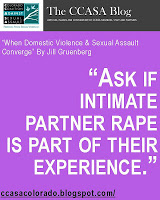By Jill Gruenberg, CCASA Blogger
Those who work in the field of sexual assault are very familiar with the statistic that according to the 2005 National Crime Victimization Study by the U.S. Department of Justice 73% of sexual assaults were perpetrated by a non-stranger. Perhaps it is as a friend, an acquaintance, a family member, a teacher, a coach, a co-worker, or others in positions of trust. In addition, those in dual domestic violence/sexual assault agencies know that sexual abuse is a significantly occurring and effective form of violence and control that abusers employ upon their partners. Yet perhaps the greatest irony is that even those of us who are trained to understand and recognize the co-occurrence of domestic violence and sexual assault are often the last to ask our own clients if they have experienced Intimate Partner Rape (IPR). Ask yourself this: do you fill out your forms or keep your statistics as if an individual is either a domestic violence victim or a sexual assault victim? The painful truth is that more than we’d like to admit it, they are both. If we’re not even comfortable asking our clients if they’ve experienced sexual victimization from their partner, then who will? And if we’re not honest, direct, and secure while discussing this reality with our clients, then how can we expect them to feel safe enough to share their most intimate violation when most survivors are unable to name their experience as rape themselves?
According to the article “Criminalizing Spousal Rape”, researchers estimate that 14% of married women in the United States will at some point experience spousal rape (Resnick, Kilpatrick, and Vernonen 1991). That is 1 in every 7 married women raped by the “men that they love”. For battered women the numbers experiencing IPR jumps to 30 – 40% (Bergen, 1996; Finkelhor & Yllo, 1985; Russell, 1990).This is not to say that Intimate Partner Rape doesn’t also occur in non-married couples as well as homosexual couples. In alarming yet telling research with sentenced domestic violence and sexual assault offenders, Mervyn Davies sheds a light on the high prevalence of IPR (Intimate Partner Rape among Domestic Violence and Sex Offenders: Clinical Applications). His 2009 study of 101 sex offenders and 148 domestic violence offenders found that 89% of domestic violence offenders self-reported IPR. Davies findings also include the startling discovery that domestic violence offenders were more likely than sexual assault offenders to perceive forceful, obsessive, and sadistic rape as consensual. And most significantly, domestic violence offenders were also more likely than sexual assault offenders to perceive non-physical sexual coercion as acceptable. What this speaks to is the fundamentally flawed belief that some in intimate partner relationships still cling to the entitled idea that the relationship itself is all the consent required for sexual intimacy. While efforts to criminalize marital rape began in the 1970s, it was not until 1988 that Colorado fully recognized marital rape and removed any remaining statutory exemptions or special requirements in order to prosecute the crime. Sadly however, this is perhaps the most under-reported and under-prosecuted crime, even compared to the dismal statistics of other forms of sexual assault.
As we all know, rape is not about sex; it is about power, violence, and control. According to the website Band Back Together, this plays out in the varying forms of IPR. Anger rape is violent and retaliatory, and often used to punish the victim. Sadistic rape is used to cause pain or humiliation to the victim. Power rape uses intimidation and coercion instead of force and often follows episodes of physical abuse as a way to “make-up”. Obsessive rape involves one person insisting on or fixating on repeated bizarre fetishistic sexual acts without the consent of their partner.
 Whatever form IPR takes, it is time that we as advocates open our eyes to its prevalence. We are all sensitive to the great physical, emotional and economic pain that domestic violence victims experience. Yet imagine in addition to suffering in all of those facets of one’s life, if you also had to endure the breach and desecration of your sexual self. As we enter into October and the increased consciousness of Domestic Violence Awareness Month, let’s use this as an opportunity to bring honesty to ourselves, our work, and our clients who most need us to know and ask if Intimate Partner Rape is a part of their relationship.
Whatever form IPR takes, it is time that we as advocates open our eyes to its prevalence. We are all sensitive to the great physical, emotional and economic pain that domestic violence victims experience. Yet imagine in addition to suffering in all of those facets of one’s life, if you also had to endure the breach and desecration of your sexual self. As we enter into October and the increased consciousness of Domestic Violence Awareness Month, let’s use this as an opportunity to bring honesty to ourselves, our work, and our clients who most need us to know and ask if Intimate Partner Rape is a part of their relationship. Jill Gruenberg has worked for 7 years as the Advocacy and Prevention Program Coordinator for RESPONSE: Help for Victims of Domestic Violence and Sexual Assault in Pitkin County. She is grateful to MESA: Moving to End Sexual Assault for the wonderful introduction to the field of advocacy and working with sexual assault survivors.



I appreciate how this blog promotes understanding of domestic violence and sexual assault as an combination of interpersonal violence, not as an either/or concept. Thank you for promoting awareness.